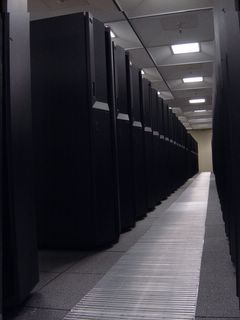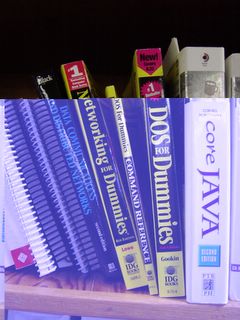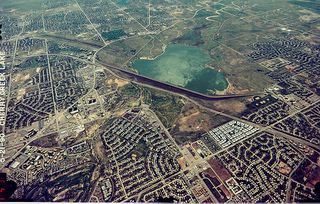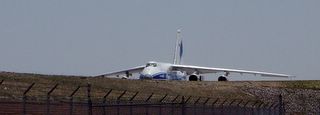While at a NASA conference in Orlando this week, a group of us got the opportunity to go to the Kennedy Space Center (KSC). It certainly is a lot better now than it used to be... I remember touring the KSC Visitor's Center just after Apollo had ended, and being astonished, embarrassed even, by how shoddy, dirty, and pathetic the whole place looked. Knowing how slick the PR machine is at NASA HQ in Washington, I'm amazed that KSC let it go so long without doing something about it.
We were able to get to a few places the regular tour does not go, including a drive around Launch Pad 39A - Discovery was undergoing a tank pressure test on 39B, and so we could not get very near that.

39B wide shot 
There was some construction work going on, apparently some modifications to the gantry - you can see the crane looming over the complex here, and the water tower that is used to douse the exhaust from the Main Engines and SRBs.

Lightning rod on 39A gantry 
Here's a close up of the lighting rod on the top of the gantry - I learned that these gantries are still the Apollo gantries, only they have been shortened considerably. And of course the launchpad crawlers are still the originals, so we don't build everything from scratch again for each new mission series...

Swing-away gantry clean room 
I knew that the new gantries include a swing-away section that encloses the shuttles' cargo bays, but I did not realize that these are able to provide a clean-room environment to work in. Impressive. You can see the general shape of the shuttle in the swing-away from this angle.

Hydrogen tank 
Here's a shot of the liquid hydrogen storage tank - you can see the liquid oxygen tank on the right in the distance. For obvious reasons, these two are kept separated until the last possible hours of launch preparations. We had to empty our pockets of all matches and lighters to get onto the site.
After the 39A tour, we went to see the ISS payload processing facility. They had just reopened it after the 9/11 clamp-down, and we were one of the first groups to go through. For the general public, part of the increased security consists of having to pay an extra $50 for that part of the tour. Apparently, terrorists are so poorly financed they can't afford US$50. Well, to be fair, they put in a whole lot more plexiglass. Here's one of the logistics modules being loaded:

MPLM in SSPF 
The loading arm is covered in fabric bellows to keep lubricant and dust from dropping into the module, and every move is being videotaped. Cataloging all that still and video footage must be a nightmare.
From there we went to the major change at the KSC visitor facilities: the Saturn V 'museum.' Well worth the visit, and a worthy display for this piece of historic hardware. Much more so that the rusting hulk that used to sit outside, a full Saturn V sits on its side, and a 400 foot long stroll gives you the full effect. Here's the business end of the first stage, which greets you as you enter the hall:

Five F-1 engines 
Several stages later, you get to the Command and Service Modules. Continuing my engine fetish, here's the business end of the Service Module:

SM Propulsion System 
Finally, we ended up at the outdoors section (the old "rocket garden"), and the astronaut memorial.
I shot a lot of pictures there, but will only post this one, even if it is slightly corrupted... argh. The larger version is better. Rather than another engine shot, I figured this was the real 'business end' of the shuttle, since it has to nose its way back into the atmosphere at several thousand miles an hour...

Shuttle schnozz 


















